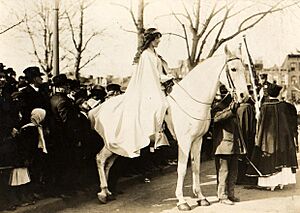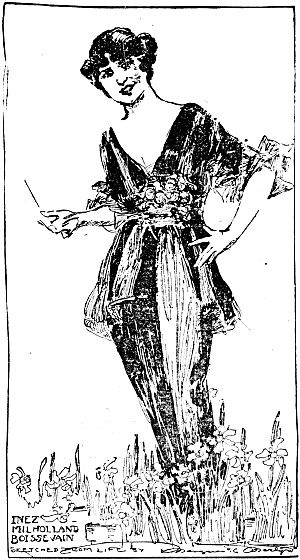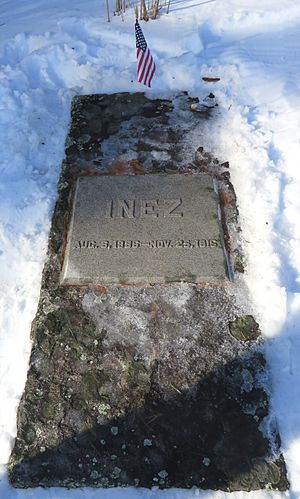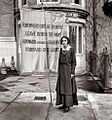Inez Milholland facts for kids
Quick facts for kids
Inez Milholland
|
|
|---|---|
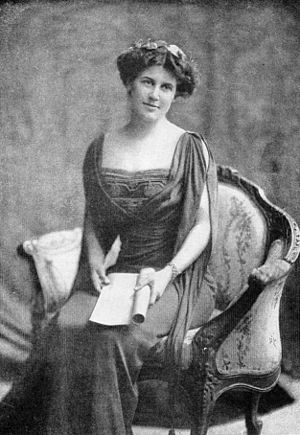 |
|
| Born | August 6, 1886 Brooklyn, New York
|
| Died | November 25, 1916 (aged 30) Good Samaritan Hospital, Los Angeles, California
|
| Education | Vassar College, NYU School of Law |
| Spouse(s) |
Eugen Jan Boissevain
(m. 1913–1916) |
Inez Milholland Boissevain (born August 6, 1886 – died November 25, 1916) was an important American leader who fought for women's right to vote. People who supported this cause were called suffragists.
From her time at Vassar College, Inez strongly supported women's rights. She believed this was the most important part of her wider goals for a fairer society. In 1913, she famously led a large parade for women's suffrage. She rode a white horse before President Woodrow Wilson's inauguration. She was also a lawyer and a reporter during wartime. Inez was known as a modern and independent woman for her lifestyle. She sadly passed away while on a speaking tour, even though doctors told her not to travel.
Contents
Early Life and Family
Inez Milholland was born and grew up in Brooklyn, New York. Her family was quite wealthy. She was the oldest daughter of John Elmer Milholland and Jean Milholland. She had a sister named Vida Milholland and a brother named John.
Her father was a reporter and writer for the New York Tribune newspaper. He later ran a successful business. This allowed his family to live comfortably in both New York and London. In London, Inez met Emmeline Pankhurst, a famous English suffragist, and was very impressed by her. Inez's father supported many important changes, including world peace, civil rights, and women's right to vote. Her mother made sure her children learned a lot about culture and ideas. Inez spent her summers on her family's land in Lewis, Essex County, New York. This property is now the Meadowmount School of Music.
Inez Milholland's Education
Inez Milholland first went to school at the Comstock School in New York. She also attended Kensington Secondary School in London. After finishing school, she wanted to go to Vassar College. However, Vassar did not accept her graduation certificate. So, she went to Willard School for Girls in Berlin instead.
During her time at Vassar College, Inez was once suspended. This happened because she organized a meeting about women's rights. The president of Vassar had banned such meetings. But Inez and other students held regular "classes" on the topic. They also organized large protests and signed petitions.
Inez was known as a very active student who wanted change. She held a suffrage meeting in a cemetery when she couldn't on campus. She started the women's suffrage movement at Vassar. She convinced many students to join and taught them about social fairness. Inez was the president of the campus Intercollegiate Socialist Society. This group was mostly made up of women at the time. It showed how much they cared about people who were treated unfairly. Inez believed that working for a fairer society was "a vital means to correct the monster evils under the sun."
She was also a talented athlete. She was the captain of the hockey team and a member of the 1909 track team. She even set a record in the basketball throw. Inez also took part in student plays, the Current Topics Club, the German Club, and the debating team.
After graduating from Vassar in 1909, Inez wanted to study law. She tried to get into Yale University, Harvard University, and Cambridge University. But she was turned down because she was a woman. Finally, Inez was accepted into the New York University School of Law. She earned her law degree in 1912.
Inez Milholland's Careers and Activism
Inez Milholland cared about many different causes. She was interested in improving prisons. She also worked for world peace and equal rights for African Americans. Inez was a member of several important groups. These included the NAACP and the Women's Trade Union League. She also joined the National Child Labor Committee, which worked to stop child labor.
She was involved with the National American Woman Suffrage Association. This group later became the NWP. Inez became a leader and a popular speaker for the NWP. She worked closely with other suffrage leaders like Alice Paul and Lucy Burns.
Becoming a Lawyer
After becoming a lawyer, Inez joined a law firm in New York. She worked on criminal and divorce cases. In one of her first tasks, she went to investigate conditions at Sing Sing prison. At that time, it was unusual for women to talk with male prisoners. But Inez insisted on speaking directly with the prisoners. She wanted to find out about the difficult conditions inside the prison.
Leading the Suffrage Movement
Inez Milholland took part in her first suffrage parade on May 7, 1911. She carried a sign that said, "Forward, out of error,/Leave behind the night,/Forward through the darkness,/Forward into light!" Inez quickly became a well-known face of the suffrage movement. The New York Sun newspaper said that "No suffrage parade was complete without Inez Milholland."
Suffrage leader Harriot Stanton Blatch asked Inez to lead parades in 1911, 1912, and 1913. Her most famous appearance was on March 3, 1913. This was the day before President Woodrow Wilson's inauguration. Inez, who was 26, helped organize the Woman Suffrage Procession in Washington D.C. Alice Paul placed her at the front of the parade. Inez wore a crown and a long white cape. She rode a large white horse named "Gray Dawn." Horses became a common way to spread information about the suffrage movement. Other suffragists, like Claiborne Catlin Elliman, also rode horses to raise awareness.
Inez Milholland believed that women should have the right to vote because of their unique qualities. She argued that women would help "clean up the nation." She thought women's votes could fix social problems. These included unfair workplaces, crowded living conditions, hunger, poverty, and high rates of child deaths. She told men not to worry about women voting. She said women were simply extending their important duties from the home to the whole country. Even though she spoke about these serious issues, she was often sad that people noticed her looks more than her intelligence.
The last words of her final speech for women's suffrage were, “Mr. President, how long must women wait for liberty?"
Working for Peace
Inez Milholland traveled to Italy at the start of World War I. This was shortly after a German submarine attacked the RMS Lusitania ship. After landing, the ship's captain told Inez that a German submarine had followed them across the ocean. With this information, she began writing for the Tribune newspaper. She became a war correspondent, reporting from the war zone. Inez tried to visit the front lines of the war. She continued to write articles against the war. This led the Italian government to criticize her, and they eventually banned her from the country.
When she returned from Italy, Inez felt very disappointed. She believed she had been kept from the front lines because she was a woman, not because she was against the war.
She was also a key person on Henry Ford's "Peace Ship" trip in late 1915. She sailed across the Atlantic with other peace activists. They hoped to encourage a peaceful end to World War I. However, she left the ship in Stockholm because the trip was not well organized.
Personal Life
Inez Milholland was seen as a "New Woman" in the early 1900s. This meant she was modern and independent. She enjoyed new dances like the Turkey Trot and the Grizzly Bear. She also loved traveling to Paris and buying fashionable French dresses.
In 1913, while on a trip to London, Inez proposed to Eugen Jan Boissevain. He was a Dutchman she had known for about a month. They got married on July 14 at a registry office in Kensington, London. They did this as soon as they could after arriving, without telling their families first. Inez's father, John Milholland, was in New York and heard about the marriage from the news. He wanted them to get married again in a church, but Inez refused.
A problem came up when the couple returned to New York. Inez was no longer considered an American citizen. At that time, a law said that if an American woman married someone who was not American, she would take her husband's nationality.
Inez Milholland loved children, but she and Eugen never had any of their own.
Death
In 1916, Inez went on a speaking tour in the western United States. She spoke about women's rights as a member of the National Woman's Party. She went on this tour even though she was suffering from a serious illness called pernicious anemia. Her family was worried about her health and told her not to go, but she went anyway.
On October 22, 1916, she collapsed while giving a speech in Los Angeles, California. She was rushed to Good Samaritan Hospital. Despite getting many blood transfusions, she passed away on November 25, 1916.
Legacy and Remembrance
After Inez died, her sister Vida Milholland dedicated her time to working for women's right to vote. Vida even went to prison for three days in 1917 for her activism.
As a tribute to Inez Milholland, a mountain in the Adirondacks was renamed Mount Discovery in her honor.
The poet Carl Sandburg wrote a poem about Inez Milholland called "Repetitions." It was published in his 1918 book, Cornhuskers. Another poet, Edna St. Vincent Millay, also wrote a poem for Inez. This poem, "To Inez Milholland," is in her collection The Buck in the Snow. Edna St. Vincent Millay later married Inez's widower, Eugen Boissevain, in 1923.
Inez Milholland was played by actress Julia Ormond in the 2004 movie Iron Jawed Angels.
A special teaching position at New York University School of Law was named in her honor. It is called the Inez Milholland Professorship of Civil Liberties.
Images for kids
See also
 In Spanish: Inez Milholland para niños
In Spanish: Inez Milholland para niños


